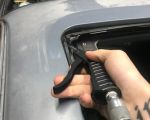Quick Emergency Tire Changes on the Road
- Importance of Tire Maintenance
- Understanding Common Tire Problems
- Tools You Need for Tire Change
- Step-by-Step Guide to Changing a Flat Tire
- When to Call for Professional Help
- Tips for Preventing Future Tire Issues
Importance of Tire Maintenance
Tire maintenance is an essential part of vehicle care, and it plays a significant role in road safety. Tires are the only point of contact between your car and the road, which means that any issues with them can lead to dangerous situations. Regularly checking your tire pressure, tread depth, and overall condition can help prevent flat tires and blowouts. Keeping your tires in good condition ensures better traction, handling, and fuel efficiency. In this article, we will explore how to change a flat tire quickly and efficiently, especially when you're on the road and need a fast solution.

MR. TIRE INC.
2078 New York Ave, Huntington Station, NY 11746, USA
Understanding Common Tire Problems
Before diving into the specifics of tire changes, it's important to understand the most common tire issues that drivers face. Flat tires are the most frequent problem, but they can arise from various causes such as punctures, poor inflation, or damage from road hazards like nails or glass. Another common issue is tire wear, which can happen unevenly due to improper alignment or inflation. Additionally, tire blowouts, which occur when the tire bursts due to excessive heat or wear, can happen suddenly and without warning. Recognizing these signs early can help you avoid being caught in an emergency situation on the road.

MR. TIRE INC.
2078 New York Ave, Huntington Station, NY 11746, USA
Tools You Need for Tire Change
To change a tire successfully, you'll need a few essential tools. First, ensure you have a reliable car jack, a lug wrench to remove the tire bolts, and a spare tire. A tire iron can be helpful for tightening bolts. It's also recommended to carry a tire repair kit that includes a patching tool and a can of tire sealant for temporary fixes. Keeping these items in your vehicle will allow you to address tire problems quickly and avoid waiting for assistance in inconvenient locations. Having the right tools is crucial to ensuring a smooth and efficient tire change process.
Step-by-Step Guide to Changing a Flat Tire
Now that we understand the importance of tire maintenance and the common problems, let's dive into the actual process of changing a flat tire. Follow these steps:
- Ensure Safety First: Park your vehicle on a flat surface, away from traffic. Turn on your hazard lights and apply the parking brake.
- Loosen the Lug Nuts: Using the lug wrench, loosen the lug nuts on the flat tire slightly, but do not remove them completely.
- Lift the Car: Use the jack to lift the car off the ground. Make sure it is secure and won't slip.
- Remove the Flat Tire: Once the car is lifted, completely remove the loosened lug nuts and take off the flat tire.
- Install the Spare Tire: Place the spare tire onto the wheel hub, ensuring it fits snugly.
- Tighten the Lug Nuts: Hand-tighten the lug nuts back onto the new tire, then lower the car and fully tighten them using the lug wrench.
- Check the Tire Pressure: Ensure the spare tire is properly inflated before driving off.
Changing a tire can be simple if you follow these steps. Always be cautious and take your time to ensure safety throughout the process.
When to Call for Professional Help
In some situations, attempting to change a tire on your own may not be feasible or safe. If you’re on the highway, in inclement weather, or have physical limitations, calling a towing service is the best option. Professional roadside assistance can save you time and effort, especially if you don’t have the right tools or if the spare tire is not in good condition. It's always a good idea to have a reliable towing service, like Rescue & Towing, saved on your phone for emergencies.
Tips for Preventing Future Tire Issues
Preventing tire problems before they occur is essential for avoiding the hassle of roadside tire changes. Here are a few tips:
- Check Tire Pressure Regularly: Under-inflated or over-inflated tires are more prone to damage. Use a pressure gauge to check monthly.
- Inspect Tire Treads: Ensure your tires have enough tread depth to grip the road effectively. Replace them when the tread wears down.
- Avoid Road Hazards: Always be aware of your surroundings and avoid hitting curbs, potholes, or debris that could damage your tires.
- Rotate Tires Regularly: Rotating your tires every 6,000 to 8,000 miles ensures even wear and prolongs tire life.
By staying proactive with tire maintenance, you can avoid many common tire problems and reduce the chances of needing an emergency tire change.
Conclusion
Knowing how to change a flat tire is an essential skill for any driver. By understanding the common tire issues and being prepared with the right tools, you can quickly handle most tire emergencies. If you’re not comfortable changing a tire yourself or are in a situation where it’s unsafe to do so, don’t hesitate to call for professional help. Keeping your tires in good condition and taking steps to prevent future issues will ensure a smooth and safe driving experience. For any roadside assistance needs, Rescue & Towing is here to help with fast and reliable services.




























